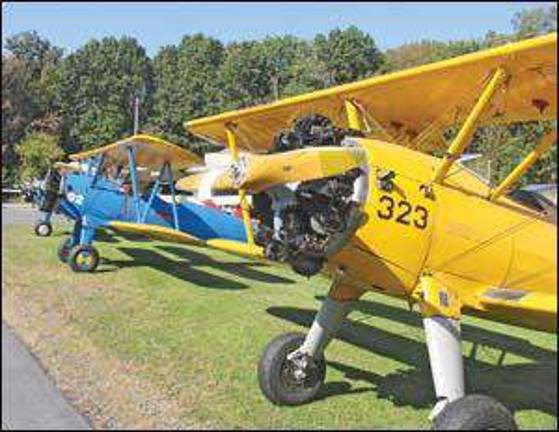Warwick Municipal Airport hosts tenant appreciation day

WARWICK It was a picture perfect day with clear blue skies and warm temperatures that made it feel more like summer than fall. On Sunday, Oct. 9, Warwick Municipal Airport hosted its annual tenant appreciation day featuring a static display, musical entertainment and lots of food. Unlike many of the airport’s community events such as the annual Experimental Aviation Association (EAA) Annual Fly-In, this event was geared to thanking the approximately 50 local pilots and their families who base their aircraft at the picturesque airport. And more than a few of the tenants are owners of vintage airplanes with historic manufacturers’ designations like Stearman P17, Boeing P23, Cessna L-19 Bird Dog and Tiger Moth. “This is an interesting and unique collection,” said Airport Manager Dave Mac Millan, “and what is more interesting is that all these airplanes are based right here in Warwick.” Town of Warwick Supervisor Michael Sweeton also paid a visit to the airport that morning. The town, which leases the field to the Pilots Association, owns Warwick Municipal Airport. Two years ago, thanks to the efforts of the Warwick Valley Pilots Association, the Town of Warwick received a $50,000 grant from New York State for badly needed improvements to the airport’s hard surface runway and turn off areas. Warwick Municipal Airport is a public-use airport located approximately three miles northeast of downtown Warwick. Counting the parallel grass or turf surfaces to the north/south asphalt runway and the east/west grass runway, the airport technically has six runways. Origins begin in 1926 According to “Orange County Airports Past and Present,” by June Simpson, Warwick-Wickham Airport, now known as Warwick Municipal Airport, has a history dating back to 1926 when Mary F. Clark deeded farmland to the Wickham Lake Development Corporation, which had plans for the establishment of an airport for early pilots. In 1932 development of the airport became a Works Progress Administration (WPA) project, which was completed in 1938. By then, the Town of Warwick had already purchased the 86 acre airport for $5,000. Ed Gorski, who had served as Amelia Earhart’s mechanic, and his wife, Julia, managed the airport in 1942 when it was selected as a Civilian Pilot Training Program during World War II. An interesting anecdote in Simpson’s book is that in the 1950s, the famous radio personality Arthur Godfrey flew into Warwick in his twin engine DC-3. It was a large aircraft for its day and Godfrey’s arrival caused lots of excitement. It would be just as much a surprise today. In 1967 the Town of Warwick purchased an additional 41 acres for the airport. During the 1970s the airport fell into disrepair but in 1983 the Warwick Valley Pilots Association leased the field from the Town of Warwick and immediately made dramatic improvements. The association also initiated its own “good neighbor” rules and regulations for the direction of flight in the local traffic pattern and banned “touch and go” practice landings and take-offs as well as transient night landings. The Warwick Municipal Airport also sponsors several events each year that are open to the public as a community service. “Our entire operation,” said Mac Millan, “is geared to maintaining positive and friendly relations with our neighbors and everyone in Warwick. We are always sensitive to their concerns.”